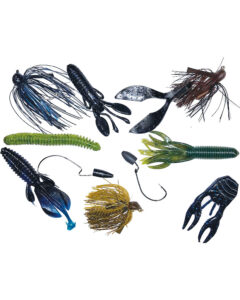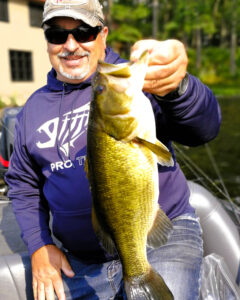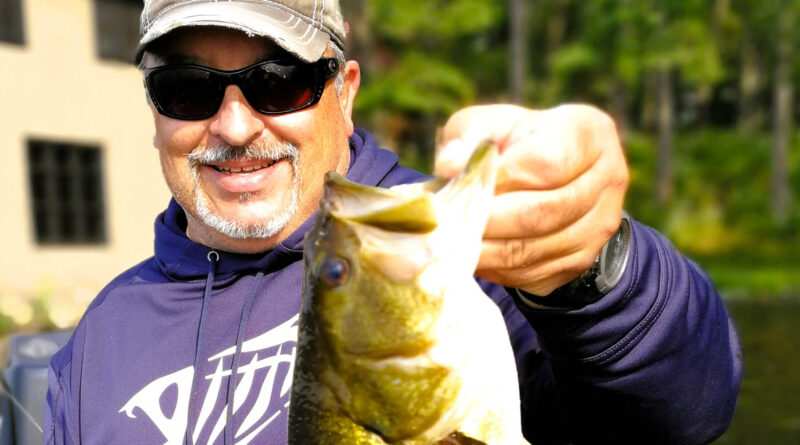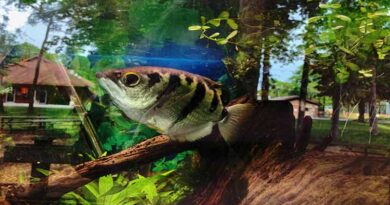Get Skinny for Fat Bass!
No. This isn’t about one of those new FAD diets to help you “look your best this summer”, but if you’re into Fat, Portly, Pot- bellied Largemouth Bass, then you need to try getting Skinny!
Although I love to fish topwater lures and cast jerkbaits out in the depths, every once in a while I grab the heavy artillery and head for the shallows to do battle!
One could argue that the term shallow water is very vague, and I would agree, so for the purposes of this article, lets assume we are talking about water with a depth of 4 feet or less. One thing that every body of water has, no matter where you fish, is shoreline, and believe me, there is no end to the number of different fishing opportunities you stumble across while fishing it. Docks, fallen trees, matted weeds, stumps and just about anything else you can think of, offer cover and ambush points for Bass lurking in the shallows. Of course, it would be too easy if every single dock and fallen tree had a giant Bass sitting under it waiting for your offering, so here’s a few things I like to look for that will up your odds.
 The sweet spots
The sweet spots
No matter what type of cover you encounter along the shoreline, there will most likely be a high percentage area or “sweet spot” on it that will hold a bass. A prime example of this is where there might be a deeper section under a dock for instance. If you are lucky enough to find a dock that has a deep spot under it, you will most likely catch a Bass off it every time you fish it. Docks offer shade and a safe haven for small fish, such as Perch and Bluegill, which then in turn, attract larger predators like Largemouth Bass.
A dock, or even a fallen tree for that matter, that have deep spots under them are magnets to Bass looking for an easy meal or a place to hide. The deeper water offers cooler temperatures and combined with the shade, help conceal hungry Bass. Often, boat owners will create a clean deep spot at the end of the dock simply by coming and going as the thrust of the motor propeller creates a “hole” as they reverse away from the dock. These areas tend to hold Bass when the boat is tied up to the dock. Aggressive fish will lay in wait under the shadow of the boat watching for unsuspecting prey to swim across the open area.
Stumps and large boulders along the shoreline can also be productive. Pay attention to the shaded areas and make note that the position of the fish will change as the angle of the sun moves throughout the day. Cover that is hard to access by boat, or those hard-to-reach areas on a dock are often neglected and underfished by anglers so it can be rewarding to spend some time getting to those areas as well. I never worry about how I’m going to land a big fish, my first priority is to hook him.
Other types of cover you will encounter in the shallows are weed mats or “slop” as well as Lily pads. Weed mats consist of living or “chopped up” weeds that have been packed together by wind or boat traffic and spread out to create a dense canopy of floating vegetation. Typically, I like to concentrate on small outcroppings that extend away from the main mat or pad bed. These points often hold the most aggressive fish and are easy to target. Once you fish the points and outside edges, you can try throwing your bait further into the cover where the inactive fish that are not willing to chase a bait will be positioned. Most Largemouth Bass find it difficult to pass up an offering going right past their nose!

You’re going to need a bigger boat
Well not really, but you are going to need bigger tackle. If you head into the shallows thinking your 10lb test line spooled on a medium action spinning rod is going to be able to winch a Bass out of the middle of a weed mat, then you are in for a very frustrating day of fishing. I like to use at least a 7′ 5” Medium-Heavy or Heavy action Baitcasting rod spooled with at least 40 pound braided line. It is critical that you can power these Bass out of the cover and get them coming to the boat. Once they have an opportunity to dive under the cover, they will wrap themselves up on something and most often pull free. I like to throw a lot of soft plastics in shallow, and I usually Texas rig them on a heavy 4/0 flipping hook. The size of the weight is determined by how heavy the cover is I’m fishing but you can usually get away with a 3/4oz for most applications. I also like punching through the weed mats with a heavy jig equipped with some sort of crawfish imitating plastic trailer. 3/4oz and 1oz sizes get it done for me.
For those of you who want to try an exciting “hand to hand” combat style of fishing this summer, bust out the heavy equipment and point your boat towards shore. There are a lot of big ones getting skinny!
Good Luck and get outside!
Mike Quesnelle, GOAT Angling Adventures
www.goatanglingadventures.ca
(705) 934-1450




